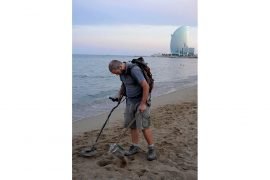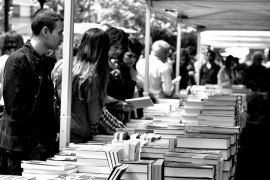[dropcap letter=”I”]
f Wall Street had been a monarchy, Madoff would have been its greatest king. As such, he lived for decades. The great fortunes, the funds, the great investment banks from Wall Street and from half of the world queued up at his offices to request a hearing and get the king of finances, the greatest guru in the whole history of markets, to keep part of their capital and invest it and turn it into pure gold. But today, the respected financier who seemed to have the Midas touch is languishing working behind bars in a federal prison serving a 150-year sentence for fraud. The highest sentence in history, in line with the massive fraud committed. The story of Bernard Lawrence ‘Bernie’ Madoff has always required capital letters.
The pyramid scheme persisted for a long time because money flowed and there was always new capital interested in getting involved and because, there had never been too many requests to withdraw capital at the same time. But this all changed in the fall of 2008
Everything changed on the night of December 10, 2008. That evening, Madoff gathered together his wife Ruth and his two sons, Mark and Andrew, in his luxurious apartment in Manhattan, and admitted that the thousands of millions of dollars that his investment firm was supposed to manage by investing on operations in markets from half of the world were, in fact, a few hundreds of millions deposited in a current account at Chase Bank in New York. Madoff had spent half of his life swindling the investors using a form of pyramid fraud similar to a Ponzi scheme, consisting in luring investors and paying profits to earlier investors by using funds obtained from more recent investors. This simple system, devoid of the slightest financial sophistication, succeeded because the Madoff ‘brand’ managed to attract money and admiration from the great fortunes.
 The pyramid scheme persisted for a long time because money flowed and there was always new capital interested in getting involved and because there had never been too many requests to withdraw capital at the same time. But this all changed in the fall of 2008. Lehman Brothers went bust and the market was facing the first wave of an incipient financial tsunami. Investors panicked and started recouping capital to face the new situation. As he would later confess his lawyer, Madoff realized what he had silently been dreading for many years. His empire, built on lies, was collapsing. In turn, thousands of millions of dollars from thousands of investors went bankrupt. The morning after this family confession, Madoff’s sons called in FBI to have his own father arrested. A few days later, US prosecutors estimated the size of the fraud to be 65,000 million dollars.
The pyramid scheme persisted for a long time because money flowed and there was always new capital interested in getting involved and because there had never been too many requests to withdraw capital at the same time. But this all changed in the fall of 2008. Lehman Brothers went bust and the market was facing the first wave of an incipient financial tsunami. Investors panicked and started recouping capital to face the new situation. As he would later confess his lawyer, Madoff realized what he had silently been dreading for many years. His empire, built on lies, was collapsing. In turn, thousands of millions of dollars from thousands of investors went bankrupt. The morning after this family confession, Madoff’s sons called in FBI to have his own father arrested. A few days later, US prosecutors estimated the size of the fraud to be 65,000 million dollars.
Madoff was not selective in destroying people’s lives: he gathered capital from great fortunes and the European nobility, but he also collected money from pension funds of middle-class holders or investment funds and banks both from the US, Europe and Asia
Bernie Madoff became not only one of the most hated men in the US but also his recurrent photograph became the epitome of the end of Wall Street’s unscrupulous golden age, the living image of a system that had triggered the worst financial crisis in decades. The world needed a scapegoat and Madoff became the ideal candidate. When in June 2009 he was sentenced to 150 years in prison, thousands of families, most owners of the best apartments in Manhattan and the best houses in the Hamptons were slightly relieved as the man who had taken a sizeable part or all of their savings would die in a federal prison deprived of luxuries. But the money still had to be recovered. This humongous task was taken over by lawyer Irving H. Picard. Over the past decade, his 50 financial investigators have only recovered a small amount of the scam, less than 20,000 million dollars.
The unveiling of the scam triggered true personal dramas and some of the fraud victims were incapable of facing what was coming upon them. Such was the case of French aristocrat Thierry de Villehuchet. He was 65 when he slashed his veins in his New York’s office
Madoff was not selective in destroying people’s lives: this financier gathered capital not only from great fortunes and the European nobility, while attending high-society parties or playing matches in one of the private clubs of which he was a member of, but he also collected money from pension funds of middle-class holders or investment funds and banks both from the US, Europe and Asia. He even “invested” money from close relatives. Madoff’s problem -as he himself would later admit- is that everybody begged him to take their money, and he did not know how to reject the offer. Ten years ago, a few days before Christmas, the pyramid collapsed and, in turn, exposed thousands of millions of dollars swindled. This is when investors across the globe shockingly discovered that they had lost everything. Spain was not spared the fraud. The National Securities Market Commission (CNMV) quantified Madoff’s scam at 106.9 million euros of funds exposure and Spanish SICAV, among which Fonditel Gestión, the management group Grup Telefónica, or Invercaixa.
The unveiling of the scam triggered true personal dramas and some of the fraud victims were incapable of facing what was coming upon them. Such was the case of French aristocrat Thierry de Villehuchet. He was 65 when he slashed his veins in his New York’s office a few days after discovering he had lost nearly 2,000 million dollars, all his estate. He was not the only one. The tragedy escalated dramatically when two years after the scandal broke out, Madoff’s elder son hanged himself in his luxurious New York apartment. Mark Madoff, like his brother Andrew -who would die shortly after of cancer-, was facing million dollar claims as former worker and executive in his father’s firm. Although the trial had relieved them from criminal responsibilities, many scam victims opted to file claims against them and their mother, Ruth Madoff. If anything, they considered them responsible of having lived a life of luxury for years on a thousand million fraud and questioned their ignorance on the source of their fortune.
When Mark Madoff took his life, he had lost all his friends. Many of them had lost their savings and others, quite simply, did not want anything to do with the Madoffs. This is what judge Chin claimed during his father’s trial. His office had received thousands of letters of claimants demanding justice. Not a single letter pleading for him. Once the most praised man in Wall Street for decades did not have a single friend.
But like all great stories, Madoff contains a moral message and a question: How can one single man evade thousands of millions without raising suspicions? In fact, somebody did see something. In 1999, an investment manager from Boston, Harry Markopolos, sent a letter to SEC (the US Securities and Exchange Commission), where he expounded his suspicions of a possible scam. The SEC did nothing about it. After all, nobody was losing money. Quite the opposite. Madoff was one of the most respected men in Wall Street. He had been one of the promoters of Nasdaq and held scores of advisory and honorary positions in many financial and charitable organizations. The system worked and Madoff spearheaded the system. The collapse of the real state bubble and the ensuing financial crisis turned everything upside down. Nowadays, ten years after, Madoff is still in prison, alone and forgotten, and Wall Street celebrates again millions of earnings and bonuses while one wonders when a new crisis will break out and, mainly, who will then be its scapegoat.


















